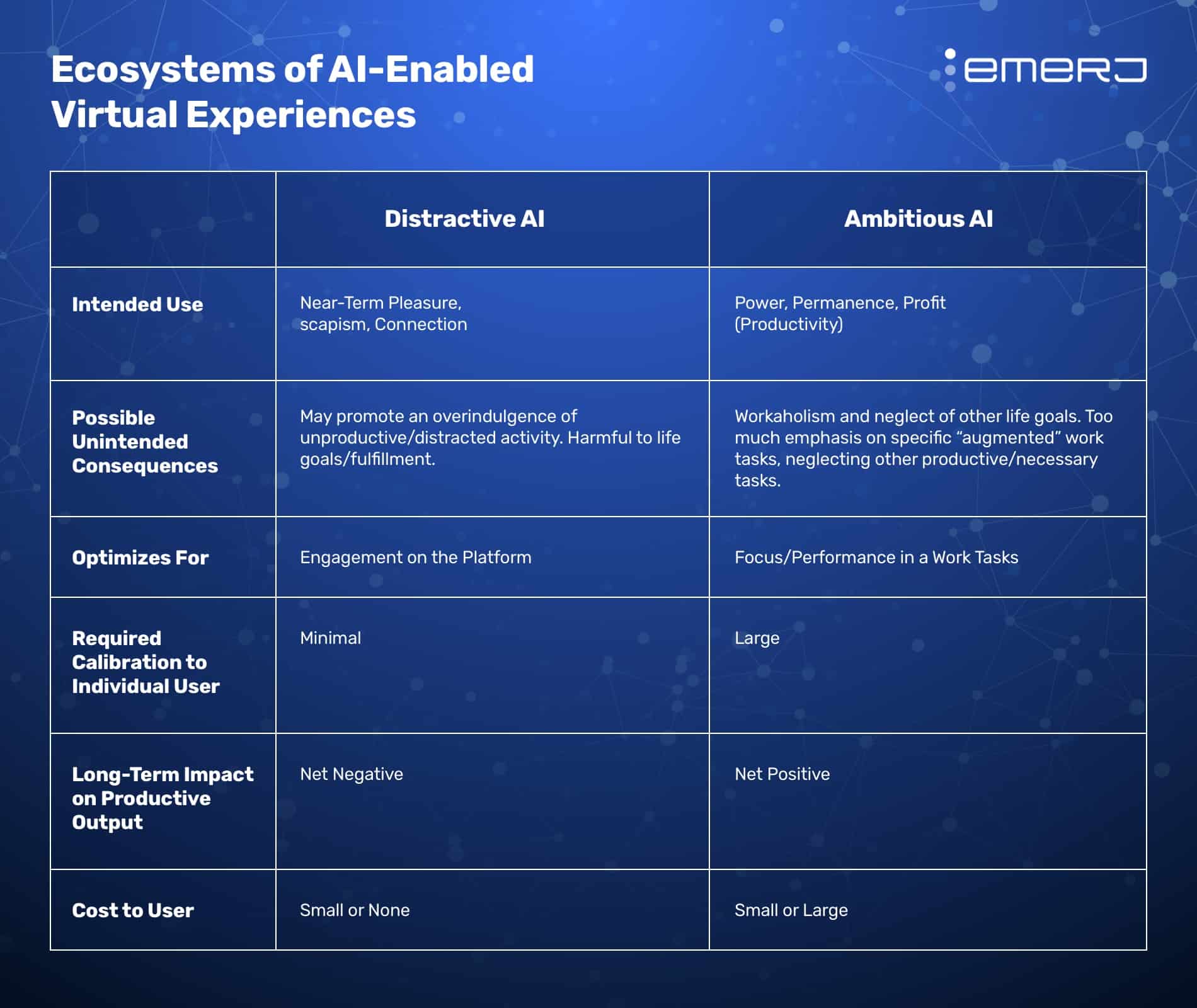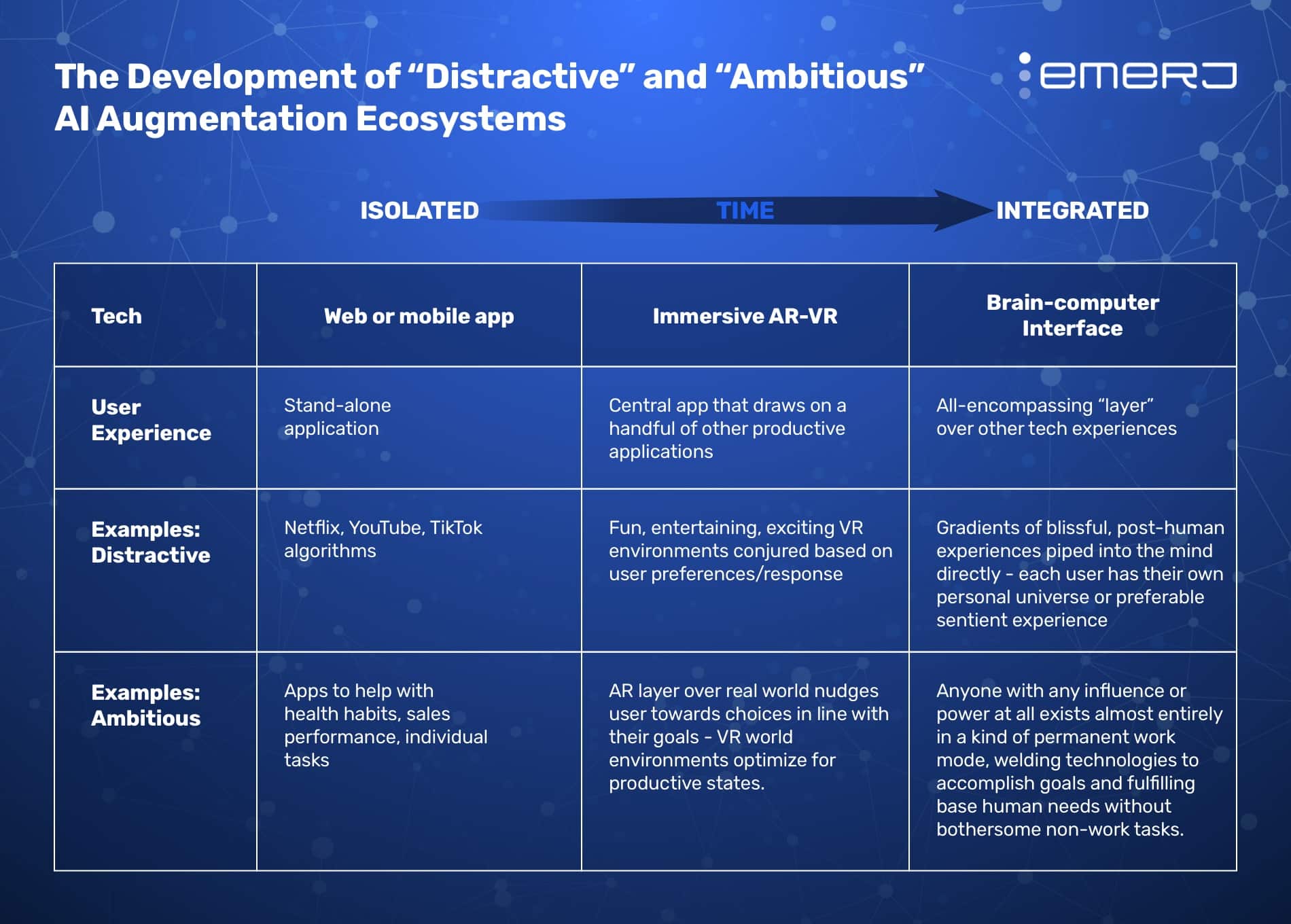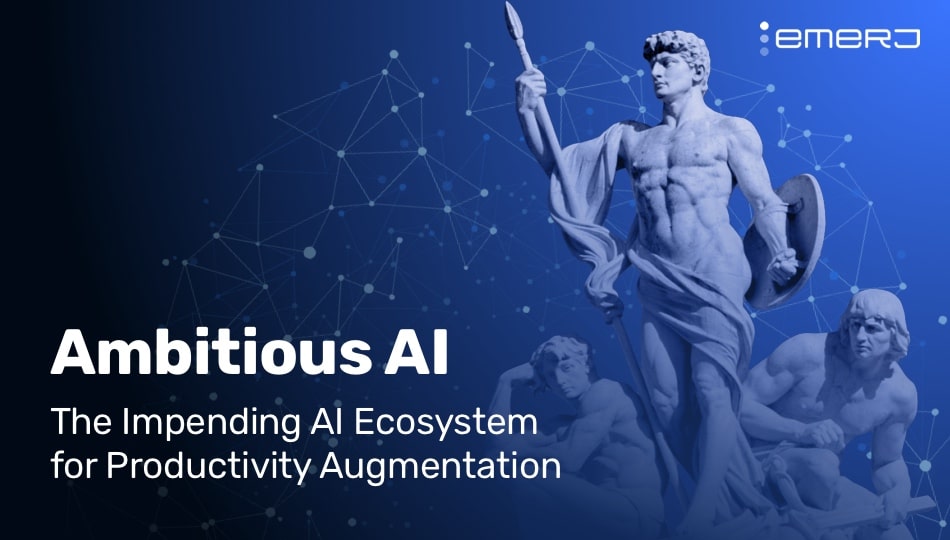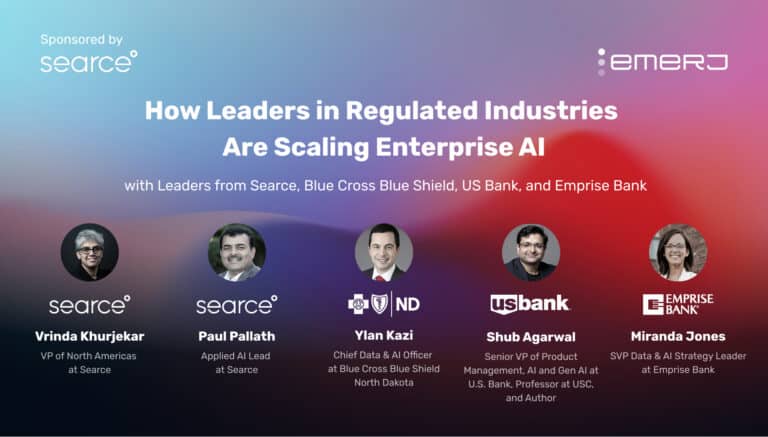About AI Power: AI Power is an article series focused on the long-term consequences of AI, and how power is or will be influenced by AI technologies. Some previous AI Power articles – including “The SDGs of Strong AI” and “AI Ethics at War” have been popular over the years – but I’ve taken a hiatus from writing AI Power articles but suspect that I’ll be creating more in 2022. I’m grateful to my friends for helping to put this first piece together – I hope you enjoy it. – Daniel Faggella
In 2010, most Americans would struggle to list the ways in which AI impacts their day-to-day life.
In 2022, many of us spend large percentages of our daily life using AI applications. They guide our route to the office, they automatically edit our photos, they find obscure products or facts, and – mostly – they entertain or distract us.
Not only has our screen time increased over the last twelve years, our “percent of screen time generated by AI” has gone up astronomically.
The most prominent of the AI interfaces we interact with today are optimized at keeping us “engaged” – maximizing for the goal of the platform itself: Revenue (through advertising, purchases, and/or maintained subscriptions).
In this article I’ll lay out a case as to why and how AI will invariably expand into a necessary addition for nearly all productive work, and how the proliferation of this trend might lead to more serious cognitive augmentation and transhumanism.
I’ve broken this article down into the following sections:
- TL;DR Summary
- Defining Terms – “Distractive” and “Ambitious” AI
- Why Entertainment and Passive AI Came First
- From the Goals of the Platform – to the Goals of the User
- AI Augmentation – From Web Apps to Brain Computer-Interface
- Quotes and Perspectives from Experts
While this article is a collection of some of my own ideas, it’s built from many great conversations with the many brilliant minds we’ve connected with at Emerj Artificial Intelligence Research. From academics, to startup founders, to United Nations AI leaders – I’m grateful to all of the friends and folks in our expert network for contributing quotes, ideas, and articles worth referencing to in this work. Their quotes are referenced throughout, as well as in the final section of the article below.
Note: This won’t be an essay assailing the founders of current AI-augmented media platforms for being malicious or detrimental to mental health. Rather, I’ll be examining trends and incentives, not the moral character of individuals.
TL;DR Summary
- Entertainment-oriented consumer AI applications (Distractive AI, appealing to the drive for pleasure) have dominated the first wave of AI-powered consumer apps mostly because of the fact that they can optimize for the same goals (engagement) across all users.
- In the decade ahead, an ecosystem of AI-enabled applications will emerge that serve to further generally “productive” goals (Ambitious AI, appealing to the drives for power and profit), and these applications will need to overcome the technical challenges of being trained on more bespoke/varied goals than many Distractive use-cases.
- Living in hyper-customized AI ecosystems becomes normal:
- In the coming 10-15 years, most people will spend most of their time in a combination of Distractive and Ambitious AI environments. To spend time in neither will be unheard-of.
- Distractive AI will appeal to people who wish for the fastest track to ease and pleasure.
- Ambitious AI will appeal to people who want to become more powerful or active through technology, rather than more satiated and passive.
- Achieving career/life goals and seeking fulfillment will both be unquestionably better pursued within AI interfaces than without them, making adoption a simple choice for most people.
- In the coming 10-15 years, most people will spend most of their time in a combination of Distractive and Ambitious AI environments. To spend time in neither will be unheard-of.
- For both Distractive and Ambitious use-cases, the user experience will go from isolated experiences to ubiquitous experiences, roughly:
- First: Web or mobile apps
- Second: Immersive AR/VR
- Third: Brain-computer interface
- The cognitive augmentation of Ambitious AI (first through apps, eventually through actual brain augmentation) will become as required for influence and power in the world or tomorrow as literacy and computer skills are for the world of today.
- The pursuit of pleasure, power, and profit in drastically personalized virtual worlds will lead to a radical shift in the human condition – and the emergence of cognitively augmented, post-human intelligences.
- The business and intergovernmental communities should consider the pathways that these technologies should develop, and prepare for a world where divergent, augmented intelligences interact primarily in a virtual – not physical – world.
Defining Terms
I’ve broken out AI’s impact on consumer technologies into two categories: Distractive and Ambitious.

Distractive AI
- Goals: Is optimized to achieve the goals of a platform (improving engagement, use time or purchases). You are wielded by it. You are marshaled toward its aims.
- Passive or active: Passive.
- Purpose: Generally designed to help the user avoid the the challenges of the state of nature (life challenges, stress from work, etc).
- Appeals to human drives: Pleasure.
- Examples:
- Web or mobile app: Netflix binging, YouTube rabbit holes, TikTok infinite scrolling, etc.
- Immersive VR/brain-computer interface: Programmatically generating an entire movie, or series of films, based on the topics/themes of interest for the user, and the desired emotional state that the user wants to experience.
Distractive AI is the use of AI primarily for distraction and entertainment – the primary goal it strives for is a change of emotional state. People want to forget their stressors and be entertained, laugh, or otherwise distract themselves. Others may want to confirm or deepen negative emotions to somehow validate or reinforce those feelings – a phenomena referred to today as doomscrolling.
Ambitious AI
- Goals: Is optimized to help you achieve or become what you want. It is wielded by you. It is marshaled toward your aims.
- Passive or active: Active.
- Purpose: Generally designed to help the user compete in the state of nature (achieve tangible goals, perform at work, get things done).
- Appeals to human drives: Power, profit, pride.
- Examples:
- Web or mobile app: AI app that helps salespeople close deals by providing them with real-time prompts on how to handle objections, or how to write follow-up or prospecting emails – based on what has worked for previous sales.
- Immersive VR/brain-computer interface: An AI application that helps entrepreneurs stay on task and grow their company – nudging them away from distraction and towards the right focus areas to further their business goals.
Ambitious AI is mostly about helping the user achieve more of user’s own goals. We might call this self-directed AI augmentation.
Most of what could be called “complex” Ambitious AI and “complex” Distractive AI is safely outside the capabilities of today’s (2022) technology – but this won’t be the case for long.
In the rest of this article I’ll explore near-term and long-term applications of self-directed AI augmentation. But first, we’ll look at why the more passive Distractive AI dominates the first wave of machine learning consumer applications.
Why Distractive AI Dominates Today
It would be untrue to say that all of the first wave of machine learning-powered consumer applications were completely Distractive.
Very few people are addicted to Google search, Waze navigation guidance, unlocking their smartphones via facial recognition, etc. Many of these applications are simply convenient, or (in the case of Google search), potentially very helpful in promoting one’s own general life goals.
The often-lamented impacts of this first wave of ML-powered consumer applications – including addiction and distraction – are largely from social and streaming media.
Facebook, Instagram, Twitter, Netflix, YouTube and TikTok are different platforms, but their goal is the same: Maximizing screen time and advertising exposure.
“You get a show or a movie you’re really dying to watch and you end up staying up late at night, so we actually compete with sleep… and we’re winning!” – Netflix CEO Reed Hastings, at the 2017 Summit LA (source)
To break down Distractive AI a bit further:
- Goal: Improve engagement, i.e.
- Time using free application – continued advertising exposure
- Time using paid application – continued subscription revenues
- Measuring Goal Attainment: Relatively easy (Is the user still scrolling? Are they using the app more often, or for longer periods of time? Are they spending more money on the platform?)
- Example: Netflix, Twitter, etc, optimizing watch time and engagement with content.
- Bespoke-ness: Very similar process to train from one user to another. There is some specificity for individuals… but that overall it’s the same end game: Keep them on the platform to either (a) see ads, or (b) pay a subscription. “Stickiness” and use are the general aim.
- User Upside: Unlimited entertainment, media, and information calibrated to our preferences/interests.
- User Downside: Constant distraction, a personally calibrated form of potentially addicting escape. Ultimately unfulfilling
- Monetary Cost: Cheap or Free
“Distractive AI” took off before self-directed AI augmentation mainly because it’s easier to optimize for distraction.
Technical Viability
Netflix, Facebook, and YouTube have enormous volumes of data to deal with, and outlandishly different preferences from one user to another. Yet from a technical standpoint, they benefit from two factors:
- A gigantic number of users. While niche productivity applications for architectural design or enterprise might acquire millions of users, general “entertainment” needs apply across careers and demographics. Paid applications like Netflix can still achieve hundreds of millions of users – and free applications like TikTok and Facebook reach billions.
- A single set of quantifiable metrics to optimize for across all users. Engagement. While it isn’t child’s play, it’s fundamentally the same process to keep a horror movie fanatic on Netflix as it is a family who likes to watch Disney movies. (Netflix’s Research/Engineering Director, Justin Basilico has a 30-minute presentation on recommendation applications that is worth watching for any layperson interested in the topic.) Each user is different, but the variables to adjust (content the user can engage with, types actions – like clicks, comments, views of a video, etc) are the same. The company’s aim is to find the right combination of experiences to encourage higher usage from the user.
Comparing Distractive vs Productive AI Use-Cases
Compare this “watch time”/“engagement” optimization to the narrow, productive challenge of optimizing for sales productivity.
An AI application for sales enablement might listen to tens of thousands of sales calls and achieve specific outcomes to help salespeople sell more, such as:
- Labeling important segments of a call, such as “introductions”, “need discovery”, “overcoming objections”, etc… – allowing sales teams to better analyze their calls.
- Labeling the sentiment of the prospect and salesperson throughout a sales call.
- Prompting salespeople during the conversation with their next statement or objective (i.e. “Move to presenting our offerings” or “Here’s how to overcome this price objection”).
- etc…
Some applications along these lines already exist. My interviews with the CEOs of unicorn firms like Outreach.io, and AI-enabled sales platforms like Chorus.ai (recently acquired for over $500MM by ZoomInfo) has lead me to see the great promise of narrow AI for sales enablement – but it’s also made some of the limitations of the technology clear: It likely won’t be replacing salespeople or astronomically improving the performance of average sales reps and time soon.
Helping a user reach their own bespoke goals is more complicated than keeping them engaged on an individual platform – it involves much more nuanced criteria of success (not simply “user using application more = good”), and, generally, a much more varied set of inputs and variables (not just “scrolls, clicks, video views, comments, etc in a single app”).
Comparing Productive AI Use-Cases to Generally Self-Directed AI Use-Cases
Now take this “sales productivity” optimization against a general optimization for “furthering the user’s life goals.”
Say we have a hypothetical user, Mary, a young lawyer with the aspiration of becoming a Senator and pushing for more environmentally friendly policies, particularly around preventing and cleaning up pollution – a cause she believes in deeply.
A kind of “general” AI application geared to optimizing for these life goals might serve in a variety of ways in Mary’s life. Here are a few hypothetical examples:
- The system might scour secondary sources about women around Mary’s age who had achieved the goal of becoming a Senator, using this information to build a kind of informed outline or plan – and presenting Mary with options for next steps based on the most viable and effective paths found in the research.
- The system might feed real-time recommendations to Mary via her smartphone of AR glasses, reminding her to study, or to network with specific political figures, etc.
- The system might help to promote Mary’s desired sleep and nutritional habits in order to ensure that she is able to perform on the job (based on general sleep and nutrition knowledge, and on Mary’s historical performance under differing food/sleep conditions over time).
- etc…
This long-term goal of becoming a Senator and reducing pollution is an inherently subjective goal, and after a day of deterring distractions and encouraging healthy habits and aiding in work productivity, an AI system would have a hard time knowing how well it performed.
Is Mary closer to, or not closer to, becoming a Senator after she took this action, or made this interim career choice, or choose to handle these emails in her inbox instead of these?
The more bespoke (customized from user to user) and abstract (not immediately quantifiable by a metric such as screen time, clicks, purchases, etc) the objectives are – the harder it is to train a viable AI system. This is evidenced by the fact that essentially all of the hypothetical use-cases listed above are outside the range of what AI applications are capable of today.
I’d argue that this challenge of handling bespoke and abstract goals is the biggest reason that Ambitious AI applications have lagged, and Distractive AI has dominated the first wave of ML-powered consumer applications.
But the desire for power and productivity is great – and the as-yet-unrealized wave of Ambitious AI applications will arrive – and it will have a profound impact on how we live and work.
From the Goals of the Platform – to the Goals of the User
There was a time when only a tiny fraction of the world’s useful information could be found on the internet.
There was a time when AI was nearly incapable of searching for content relevance beyond simple, clumsy keyword search.
During this time – though human beings had an unlimited desire to access information, and ease of access – Google search could not have come into existence. The data, the internet infrastructure, the processing power, and the machine learning state-of-the-art were not there yet.
Similarly, there have been many barriers that have prevented Ambitious AI from coming into existence, and there still are. These barriers vary by use-case, but we can take a look at a handful of the barriers that might hold back some of the more general Ambitious AI use-cases.
- Quantifiability of Actions: Amazon can train algorithms to recommend products to users in large part because it can track user behavior. A search (string of keywords), a click, an “add to cart”, and a long purchase history – all are concrete data points. Contrast this with a company like Target, whose shoppers visit in-store locations. It is much harder to get a sense of who these customers are (you don’t have to “log in” with a username and email to walk into Target), never mind what they’re interest in. For the same reason, helping users with bespoke lift goals (study for classes, making sales, writing code, hiring staff) is a hairy problem involving a lot of context and, often, not much by way of concrete data points. Ambitious AI will have to begin in narrower domains where these criteria are clear.
- Accurately Assessing and Structuring Human Goals: Someone with the goal of “becoming a Senator” or “starting a successful Indian restaurant” has other motives in mind. For some it might be prestige, for others wealth. Some need to perform just better than peers, or just well enough, while others must best anyone in the history of their field. An AI system that generally nudges users towards their goals will have to determine what these goals actually are – probably by not only taking direct instructions from a human users, buy by observing the human user’s actions – and the kind of “progress” that the human user actually seems satisfied with. (Note: AI alignment is a field unto itself. Paul Christiano’s work is a good start for readers new to the subject.)
- (Business Model Concerns): Netflix is cheap because it can reach hundreds of millions, Facebook is cheap because advertisers pay for your attention when you’re on it. Ambitious AI – if it be Ambitious AI at all – serves the goals of the user, not the advertiser. This will cost a premium, likely a significant subscription fee – and will, for most users – involve a significant amount of high-touch consulting and feedback with the provider of the service to make sure that goals, progress, and behaviors are calibrate properly, and that the device seems to be genuinely benefitting the user based on the expectations of that user. Without a million users doing the same thing, training time and high-touch calibration will probably be necessary, expensive, and in some cases, prohibitively hard.
These hurdles are significant, and probably won’t begin to be overcome for years.
Nonetheless, over the coming decade, human drives will bring about this next wave of ML applications, an ecosystem of Ambitious AI.
Humans have an innate desire to compete – and there will always be a market for whatever technologies help to wield power.
- Today the ambitious CEOs, politicians, and busy professionals are likely on their computers whenever they’re not in meetings. Anyone who doesn’t won’t compete.
- Tomorrow they will be – from the moment they awake – nudged towards their most important tasks and away from distractions by AI systems designed to maximize the use of their time. Anyone who doesn’t won’t compete.
- 15 years from now they will live immersed in a VR workspace, in an environment optimized to maintain their focus and ensure their peak performance in their tasks (strategizing, selling, negotiating, delivering on client projects, etc). Anyone who doesn’t won’t compete (more on this in a bit).
While there are many possible models for human drives, neuroscientist Nayef Al-Rodhan’s (Head of the Geneva Centre for Security Policy’s Geopolitics and Global Futures Programme) useful model suggests that in addition to pleasure – humans are driven by power, pride, profit, and permanence. There is absolutely a market for any kind of technology that helps to achieve any one of them.
The Ambitious AI ecosystem will inevitably arise because power, profit, and pride demand it. While there is a certain kind of pleasure in achievement – any user who seeks pleasure alone will likely find it more swiftly through Distractive AI.
One will be incapable of entering the ranks of the most capable and prominent persons without Ambitious AI. In fact, one may not even be employable (as people without basic computer skills or familiarity with common software applicants are often not employable today). The leaders of the most powerful nations and organizations – and essentially high-performing persons – will be those who take full advantage of these technologies.
Not all users will choose to adopt Ambitious AI. Some may opt out entirely, while others may use Ambitious AI sparingly.
Some people will avoid work and escape almost entirely into AI-generated feeds of enticing distraction and entertainment. They will be the lotus eaters.
Some people will live almost entirely in AI-gamified interfaces that encourage them to drive towards goals (financial/ creative/ career/ otherwise), making every second of work optimally productive, automating every automate-able task, and making every second of non-work (entertainment, sleep, time with friends) serve the sole purpose of fueling work performance. I’ve referred to them as world eaters.
I suspect that in the coming 10 years, most people will spend time in a mix of Distractive and Ambitious interfaces. Spending time in neither will be unheard-of.
“Analog” entertainment, and “analog” methods of striving/achieving will be – rightfully – seen as mostly laughably outdated and pointless – the same way making your own shoes from leather, or entertaining yourself with a hoop and stick seems outdated and pointless today.
This is not only because Distractive AI and Ambitious AI will become more satisfying and useful (respectively) – but because they’ll become more and more literally embedded in our lives – and in our minds.
AI Augmentation – From Isolated to Integrated Experiences
The graphic below represents how AI augmentation is likely to progress, from individual user interfaces to brain-computer interfaces:

This transition from apps to brain-computer interfaces is pulled along by both of the categories of human drives we’ve already addressed:
- Pleasure – Even with all the AI-enabled entertainment in the world, the hedonic treadmill is still real, and only by augmenting do we have a chance to experience continuous states of wellbeing. Once people live in AI-enabled VR worlds and are still unhappy, they’ll demand that we address the root of the problem: the brain itself.
- Power, profit, pride – Even with all the AI-enabled productivity interfaces in the world – the human mind still has limitations for memory, creativity, and more. As the demands of work require more augmentation, and as AI augmentation in VR becomes normal, the focus will shift to augmenting the mind itself.
Below are some examples of what Distractive and Ambitious AI applications might look like in all three phases of development:
Distractive AI Use-Cases
- Today – Web or Mobile App
- Imagine scrolling endlessly through images or videos programmatically conjured to suit their preferences and capture their attention.
- Invest real time and money into virtual games, where quests involve interactions with real and computer generated characters and personalities, where “achievement” feels real and endlessly entertaining.
- Near Future – Immersive AR/VR
- VR experiences totally customized to a user’s goals, preferences, and real-time response (EEG / EKG / eye-movement / other). Imagine a user saying “Okay Google, show me a VR movie about samurai, both from the point of view of the main character, and make sure to include vampires as the bad guys” – and having a completely programmatically generated film conjured up for your enjoyment.
- A gamified AR layer over reality itself (via contact lenses, glasses) – making environments more pleasant. Imagine every room in your home having colors, views, and musical scores calibrated exactly to what would seem pleasant to you at that time.
- Future – Brain-Computer Interface
- Swimming in a VR/AR sea of AI-generated experiences – ranging from sexual pleasure to humor to beautiful art to heroic adventure and more. Brain-computer interface and nanotechnology mostly eliminate the fetters of positive sentient experience, allowing for a near-constant experience of gradients of bliss.
- Experiencing “relationships” with programmatically generated entities who have no goal other than to fulfill your own goals – a universe designed to explore pleasurable experiences (from base pleasures to more rich pleasures from creativity, or pride – but also a wide range of positive emotional experiences that we don’t have names for right now because they exist outside the range of our present hardware).
Ambitious AI Use-Cases
- Today – Web or Mobile App
- Leverages AI-powered apps to optimize their sleep schedule.
- Uses AI-enabled software to run sales, accounting, and other discrete functions of one’s business or career.
- Near Future – Immersive AR/VR
- Some ambitious people live entirely in VR work environments calibrated to maintain focus and mood, while also prioritizing the most productive tasks. These systems are gamified to be engaging – and they deter distractions (possibly with notifications, with blocks on certain apps, or simply by making work tasks vastly more appealing in the forefront of the user’s experience).
- Ever-present AI-enabled notifications keep users abreast of exactly what should be top of mind.
- Future – Brain-Computer Interface
- For nearly all waking hour, the user is prompted to act by habits and behaviors most conducive to performance for said user’s desired goals. This might involve or include:
- Calibrated sleep and wake time, based on the circadian rhythm and previous work performance and sleep patterns.
- A configured schedule optimized to leverage their most productive tasks.
- A stream of recommendations for improving workflows and outcomes based on best-practices, historical performance, etc.
- Algorithms are trained in real-time based on user experience to handle discrete tasks (from email replies to data entry to interviewing candidates for jobs, etc), allowing the main user to only focus on the edge-cases for almost all of his/her common work tasks – thus allowing the user to be astronomically more productive.
- Brain-computer interface users will communicate huge volumes of information simultaneously without the hindrances of typing. Anyone aiming to be of use in the white collar world will positively require these technologies – just as modern knowledge workers require a cell phone and computer literacy.
- For nearly all waking hour, the user is prompted to act by habits and behaviors most conducive to performance for said user’s desired goals. This might involve or include:
If those sound monstrous, impossible and disturbing to you now, we can also be sure that commercial air travel, transgender surgeries and 10-year-olds addicted to TikTok feeds would all sound just as monstrous, impossible and disturbing to someone born in 1900.
And yet here we are today.
And there we will be tomorrow.
So while Ambitious AI applications will be much more likely to help people achieve their own goals (as opposed to the “engagement” goals of Distractive AI applications), they will also force accelerated change to the human condition – changing the nature of what achievement and power are, and how they are wielded.
The tools can only be upgraded so far until human hardware itself must be augmented, and it’s nearly inevitable that exactly this is what will happen.
In wellbeing, people will face the choice of augmentation or (comparative) unhappiness.
In productivity and creativity, people will face the choice of augmentation or irrelevance.
Nayef Al Rodhan wrote the following in a prescient 2013 article for the Swiss Federal Institute of Technology Zurich:
“When more and more people are able to opt for voluntary enhancements, this will give them a competitive edge over other individuals, posing the very real risk of fostering a dangerous divide between enhanced and unenhanced individuals.
…Making matters potentially more disruptive from a security perspective, the inequalities and differences would only be reinforced along pre-existing lines of social classes and nationalities as enhancement technologies are, and likely to remain, very expensive.”
The choice between powerlessness and irrelevance vs augmentation won’t be much of a choice at all – and at the time will seem as natural as our (comparatively monstrous) choice to live glued to computer/mobile screens for nearly every waking moment of our life and work.
Quotes from the Emerj Network
My thoughts around the Ambitious AI paradigm have been informed by many authors and thinkers, some of whom are linked above. In this final section I’d like to highlight some of the ideas contributed by outside experts and friends through the research for this article:
Considerations for Transparent Data Policies of AI-Powered Interfaces
John C. Havens, Executive Director, The IEEE Global Initiative on Ethics of Autonomous and Intelligent Systems, Author of “Heartificial Intelligence” addresses some of the adoption challenges that truly customized applications may face from savvy consumers.
It will be interesting to see if more consumers will care about the data policies of large tech firms in the USA, but I’m sure John would believe it to be a net positive if they did:
“I’d like to enter a VR/AR world and know that the company will actually care about my priorities, instead of nudging me towards ads or products. To pay X$/month and have a commitment from a firm to not share your data or be beholden to advertisers would be ideal.
To do that well, I’d argue that we need data portability and algorithmic terms and conditions for each individual user. Imagine ten dials of ten increments each, for various elements of privacy, data sharing, and preferences.”
AI Augmentation – Breaking Down or Reinforcing Existing Digital Divides?
In my short phone conversation with Irakli Beridze – Head of the Centre for Artificial Intelligence and Robotics, United Nations, UNICRI – he
“Currently we are experiencing a growing digital divide. These are something like 60 countries with formal digital strategies, 130+ countries don’t have such strategies yet. Countries with those strategies are improving faster than those without, and if that trend continues that way we may end up in a very dangerous world where a lot of countries have fallen behind.
We may see more movement of refugees and other trends that may be dangerous for everyone. Virtual worlds may have the ability to level the field in some way – but this depends on whether people in those developing countries have access to the technologies or not.”
Tech Adoption Will Be Largely Driven by Work Demands
My first interview with Dr. Robin Hanson, Associate Professor of Economics at George Mason University, was nearly a decade ago – and I’ve followed his work since.
Below is a quote from 3:30 into our AI Futures episode with Hanson, on the topic of “drivers of adoption” for AI and VR tech:
“We think of ourselves as social creatures, with this work thing off to the side – but when work demands something we listen… Over the next few decades, work will change the way to use computers…
…the fundamental push is conglomeration. Right now we do that in big cities, but remote work will allow for much more of that.”
Interestingly, Hanson doesn’t believe that AI will play a major role in what kinds of Ambitious AI tools win the most users. From a recent email exchange with Hanson:
“I don’t see such a trend as you see, and if firms get better at enticing customers to look at the world more through their frameworks, I don’t see that the value of that depends much on how much AI helps with that.”
I’d argue that AI-oriented personalization is among the most powerful forces in creating lock-in and encouraging use. TikTok, YouTube, and Facebook seem to be businesses that couldn’t exist without such AI recommendation systems to encourage use.
Ambitious and Distractive AI May Apply Mostly to Recommendation
German Sanchis-Trilles, PhD in AI – University of Valencia, CEO of Sciling (and technical advisor here at Emerj) believes that, outside of recommendation, AI might not imply an inherent pull towards Distractive or Ambitious applications.
“I don’t really see these two (Distractive AI to Ambitious AI) as being separate at all. If you think about AI as in recommender systems, then that’s true. But I think that’s only a very specific use case of AI. Let’s list some of the most popular technologies:
- Computer Vision. I would say most of the popular use cases around computer vision do not align with the three phases you are drawn out. You might need computer vision for some of the phases you mention, but then there are many other use cases (e.g., computer vision for quality control in an industrial process) which directly align with phase 2.
- NLP. Something very similar as with computer vision. For instance, machine translation has been used by professional translators for literally decades to enhance productivity, and for instance I also know that speech recognition systems are being used for similar purposes. Or NLP used for chatbots, or to route customer service issues.
- Predictive analytics. E.g. churn prediction.
- Recommender systems. Here’s where most of them are used for optimizing engagement. But even so, there are also some recommender systems that are being used for other purposes (e.g., to establish the appropriate learning plan for a student).
So even though I believe I understand the argument that you are putting through, I believe it might be a bit narrower/for a more specific kind of AI.”
I’d agree with German’s take here. Ambitious and Distractive AI are about hyper-personalization, they’re about calibrating an experience (achieving a work task, enjoying a relaxing movie, etc) to the needs and behaviors of the users. Outside of this recommendation / calibration sphere, AI capabilities are quite neutral.
Metaverse Transition Likely, and Regulation Needed
I was glad to also connect with my friend Thomas A. Campbell – Founder and CEO at FutureGrasp, former National Intelligence Officer for Technology at the National Intelligence Council. Thomas has published a number of works on regulating metaverse tech, and he shared his perspectives on some of the areas of concern for early metaverse users:
Q: Do you think this transition is likely in the next 10 years, why or why not?
“I agree that presently AI firms are focusing mostly on driving eyeballs to their platforms. There are many such competing platforms, but perhaps Meta will be the most prominent because of their huge base of billions of users and strong investments. For example, Meta just installed a full supercomputer exclusively for their metaverse applications.
There remain several barriers to larger adoption of the metaverse, such as compute power, availability and pricing of VR headsets, and overcoming the discomfort of multi-hour wearing of headsets. But I’m optimistic that with so much interest and investment, these will be overcome. So, yes, I believe we will see a serious shake-up and then eventually consolidation (M&As) of the metaverse within perhaps 10 years. Even at this stage, there is sufficient momentum to enable at least the earliest visions of metaverse-enhanced retail shopping, online concerts, etc.”
Q: Do you think such productive AI applications would be aggregately good, or mostly misguided and bad for people?
“Like all technologies, the metaverse’s AI applications will be both good and bad, and even potentially misguided. One major concern I have is that existing algorithms and our strong tendencies toward filter bubbles will naturally (and on the part of the platforms, lazily) be ported directly into the metaverse. Imagine having even a narrower world view with exquisitely targeted advertisements to you, and only you, as you navigate various metaverses. I have been actively encouraging government regulators to begin considering implications and appropriate regulations and rules for metaverse activities. If we don’t do such work now, by 10 years it will be too late.”


















